Dash 8 Q400 Return to Base After Pitot System Contaminated By Unapproved Test Kit Lubricant (Flybe G-JECR)
On 15 November 2018, Flybe DHC Dash 8 Q400 G-JECR returned to Exeter, shortly after departing for Paris Charles de Gaulle when the pilots received an intermittent ALT MISMATCH message during the climb. The UK Air Accidents Investigation Branch (AAIB) investigation revealed a difference between ‘work as imagined’ and ‘work as done’ in testing the pitot static system. In their safety investigation report the AAIB comment:
‘Work as done’ according to the Shorrock concept [discussed below] is the actual activity taken to complete the task and may occur in an environment that is subject to a variety of constraints, challenges and demands that are not ‘imagined’ or ‘disclosed’. The work done may be the product of adaptations to overcome these which, although intended to achieve the objective, may result in unintended consequences.
History of the Incident Flight
…the aircraft had been undergoing a standard maintenance check at the operator’s maintenance facility at Exeter Airport. This activity included cleaning and leak checks of the pitot static system. The aircraft was released for service on the morning of 15 November 2018.
AAIB say that:
Analysis of flight data for the incident flight indicated that shortly after takeoff the altitude from Air Data Unit 1 (ADU1) under-read the altitude from Air Data Unit 2 (ADU2) by about 50 to 60 ft, but as the aircraft climbed the altitude difference varied between 20 and 70 ft. During this same period the airspeed from the ADU1 under-read the airspeed from the ADU2 by about 3 kt.
When the aircraft levelled off at FL190, the altitude from ADU1 under-read the altitude from ADU2 by about 140 ft, and the difference between the ADU1 and ADU2 airspeeds remained at approximately 3 kt. The cruise airspeed was then reduced from about 230 to 190 kt, at which point the ADU1 and ADU2 altitude difference reduced to about 100 ft.
As the aircraft descended for the approach, the altitude difference between ADU1 and ADU2 reduced to about 20 ft and the airspeed difference increased briefly to 5 kt.
A review of previous flights of G-JECR, and data from other aircraft of the same type, indicated that during the climb it was normal to see a difference in altitude between ADU1 and ADU2 of 20 to 30 ft. This then reduced to less than a few feet in the cruise and to an average of about 5 ft during the approach. The difference between ADU1 and ADU2 airspeed during the climb and cruise was about 1 kt and during the approach, this could increase to about 3 kt.
The Pitot Static System Design
AAIB explain that:
There are two primary pitot static probes located on the left and right side of the nose fuselage, linked to ADU1 and ADU2 respectively, and a third pitot static probe on the right side of the nose fuselage linked to the standby instruments.
Pitot, or total pressure, is measured by the forward-facing hole, and static pressure by four 1.5 mm diameter holes on the side of the probe.
The two primary pitot pressures (T1 and T2) are fed directly to the respective ADU, whereas the static pressures from the two static holes from each primary probe are averaged (S1 and S2) and fed to each ADU to minimise any sideslip effect.
In normal operation all three altimeters should read similar values. The aircraft manufacturer defined the tolerances for the difference between the two primary altimeters as 60 ft on the ground, increasing to 180 ft at 27,000 ft (FL270) and is 140 ft at 19,000 ft (FL190). When there is a difference greater than these values between the ADU altitudes for more than one second, the ALT MISMATCH message appears on the PFDs.
Examination of the Pitot Static System
Examination of the aircraft revealed white ‘crystallised deposits’ covering three of the four static pressure holes on the left primary pitot static probe.
There were no deposits on the right primary probe.
Fourier Transform Infra-Red (FT-IR) spectroscopy and Scanning Electron Microscopy with semi quantitative Energy Dispersive X-ray (SEM-EDX) spectroscopy were used to chemically characterise the recovered samples and the candidate materials. The SEM-EDX analysis of the residue samples showed elevated levels of silicone and fluorine along with other lower levels of inorganic elements which could be associated with a lubricating product such as a grease. The presence of lower levels of inorganic elements suggest environmental material had collected over a period of time.
Pitot System Testing
AAIB comment that:
To perform functional and operation checks of the pitot static system, including a leak test, it is required to connect the pitot static probes to an air data test kit…supplied by a specialist company [and used on multiple aircraft types].
The primary pitot static probe adaptor is a machined aluminium tube which is slid onto the pitot static probe and has three hose connectors; one for pitot pressure [13], and one each for static pressure S1 and S2 [14].
Internally, there are seals [4, 8, 9 & 10] to enable the separate parts of the system to be tested and a knurled locking sleeve [2] to compress the seals onto the probe. A glycol and water-based lubricant (LF5050) is also supplied to aid installation.
The air data test kit used during the preceding maintenance period was checked and verified to be within calibration limits.
However, a trace amount of material was recovered from the first seal of each adaptor and the FT-IR results showed that it was a type of petroleum product, with the SEM-EX results showing elevated levels of silicone that were not consistent throughout the sample. There was evidence of damage to the knurled finish on the locking sleeves of all the adaptors
The AAIB then considered the in-service use of this test kit:
To understand how the air data accessory kit is utilised in the maintenance organisation the ‘varieties of human work’ concept, as described by Shorrock (2016) , was used. The concept breaks down human work in to four varieties: work as imagined, work as prescribed, work as disclosed and work as done. This concept provides a framework to analyse a maintenance task, and the differences between the four varieties are often indicative of missing or incomplete safety barriers.
‘Work as imagined’ is the prediction by the manufacturer of the air data accessory kit of how a maintenance organisation will connect and use the equipment. It will be based upon their previous knowledge of working practices and will be written in general terms as it will be used in many different organisations.
The technical information guide supplied with the air data accessory kit contains a description of all the individual components and a brief explanation of when each one should be used. No detailed instructions for use are included as it is the expectation of the kit manufacturer that this should be documented in the AMM. It does however include a recommendation to apply a small amount of LF5050 to lubricate the seals of the adaptor and thereby ‘insuring a smooth installation’ onto the pitot static probe.
The kit manufacturer also recommends that hand tightening the knurled locking sleeve is sufficient to enable a good seal, however this information is not included in the guide. They also stated that they have never received any feedback from operators on issues using the air data accessory kit.
A Works Order had been raised to clean the pitot static pipes.
The work order stated to perform a leak test of the main system in accordance with Aircraft Maintenance Manual (AMM) task 34-11-00-790-801 and then to repeat the leak test after the cleaning has been completed. The AMM task details the procedure to follow for the leak testing of the system including precautions, set up, required tools and the test procedure.
To connect the air data accessory kit to the pitot static probes the following instructions are given:
No further instructions are given, for example…for connecting the air data accessory kit to the pitot static probes.
AAIB comment that:
‘Work as disclosed’ is how work done is described by those who perform the task. How people describe their work can be influenced by several factors such as the audience, the context of the conversation and the potential outcome of the conversation.
The AAIB interviewed 10 avionics technicians from the maintenance organisation to understand how the air data accessory kits were used, if there were any issues or problems associated with them and whether they were aware of any non-standard practices. Two themes were disclosed which may have had an influence on the incident flight.
Although not a problem for all users, the avionics technicians noted that occasionally it can be difficult to establish a good seal between the pitot static probe and the adaptor resulting in incorrect air pressures being applied to the ADUs.
Various remedial actions were described: repeatedly removing and reinstalling the adaptors until a seal was achieved, using a set of adaptors from a different accessory kit, applying various products to achieve a seal or replacing with new seals. There was no consensus on a single solution which was successful every time and several products were mentioned, other than the approved lubricant, to achieve a seal but no evidence could be provided of specific occasions when they were used.
The air data accessory kits contain many items and the maintenance organisation have multiple kits available which are taken from a controlled tool store when required. The kits are regularly audited during which they are visually examined, leak checks are performed on the hoses and the adaptors and the kit contents are assured.
The kit used on the incident aircraft was last audited in July 2018 but at the time of the investigation it was missing the recommended lubricant and the instruction manual, some of the hoses were from another kit (identification label mismatch) and there was a bottle of ‘Snoop’ in the kit. Snoop is a commonly used water-based leak detection solution. It was stated during several interviews with avionics technicians that occasionally the approved lubricant was not available in the kit.
AAIB Analysis
During the incident flight the altitude difference between the commander’s and co-pilot’s instruments was 140 ft which equates to a pressure differential of 2.8 mb under ISA conditions.
There was good evidence from the post-flight troubleshooting that three of the four holes on the left primary pitot static probe were blocked.
Although on this occasion the altitude and airspeed errors were small and resulted in a successful return to the departure airport, a blocked pitot static system has the potential to cause a large error in altitude and airspeed information displayed to the pilots. Unreliable primary flight data has previously been a contributory factor in several accidents and serious incidents.
AAIB interviews with the avionics technicians indicated that it could be difficult to achieve an effective seal between the test adaptors and the probe and various techniques have been used to get a good seal.
Analysis of residue found on and inside the pitot static probe, as well as on the seals on the probe adaptor, strongly suggests that substances other than the recommended lubricant had been used during maintenance activity.
The test equipment supplier expected the AMM would describe how the equipment should be used.
However, the [Dash 8 Q400] AMM does not provide any details on how to install the adaptors, which products should be used, or any additional information to aid the technicians to achieve a good seal between the probe and the adaptor.
The air data accessory kit manufacturer recommends the use of LF5050 to aid installation and the avionics technicians stated that it is often missing from the kit box due to kit control issues. It is possible therefore that to ‘get the job done’ the technicians may resort to other more easily available products with the unintended consequence, in this case, of residual grease blocking some of the static holes.
AAIB Conclusion
Following scheduled maintenance of the incident aircraft, a small quantity of a silicone-based grease was blocking three of the four static pressure holes of the left primary pitot static probe. The inadvertent blockage of the static pressure holes resulted in an altitude mismatch of 140 ft between the commander’s and co-pilot’s altimeter. This may have been caused by using a non-approved grease to aid sealing the test adaptor to the pitot static probe, a task which can sometimes be problematic. The kit manufacturer’s recommended lubricant is sometimes missing from the kits and the AMM and the kits instructions do not include any details on installation or sealing.
Safety Actions
The maintenance organisation has purchased new air data accessory kits and implemented tighter tool control of the kits to ensure all the components are always available.
AAIB Safety Recommendations
Safety Recommendation 2019-010: It is recommended that Nav-Aids Ltd amend the manual supplied with air data accessory kits to include more specific installation instructions, and to include warnings against using non-approved materials to aid sealing.
Safety Recommendation 2019-011: It is recommended that De Havilland Aircraft of Canada Ltd amend the instructions in the Aircraft Maintenance Manual for the DHC-8-402 for testing pitot static probes to include more specific installation instructions, and to include warnings against using non-approved materials to aid sealing
UPDATE 6 July 2020: A response is still awaited in the first case on the Bombardier response to the latter (essential that technicians should consult the external test kit manual) has been rightly assessed by AAIB as ‘Not Adequate’.
Safety Resources
We also have written:
- Professor James Reason’s 12 Principles of Error Management
- Back to the Future: Error Management
- Safety Performance Listening and Learning – AEROSPACE March 2017
- Maintenance Human Factors: The Next Generation
- Airworthiness Matters: Next Generation Maintenance Human Factors
- B1900D Emergency Landing: Maintenance Standards & Practices
- United Airways Suffers from ED (Error Dysfunction)
- USAF RC-135V Rivet Joint Oxygen Fire: A military accident investigation has paradoxically determined that a $62.4mn fire was due to a maintenance error but that no human factors were involved.
- Inadequate Maintenance, An Engine Failure and Mishandling: Crash of a USAF WC-130H
- Inadequate Maintenance at a USAF Depot Featured in Fatal USMC KC-130T Accident
- USAF F-16C Crash at Joint Base Andrews: Engine Maintenance Error
- USAF Engine Shop in “Disarray” with a “Method of the Madness”: F-16CM Engine Fire
- Contaminated Oxygen on ‘Air Force One’ Poor standards at a Boeing maintenance facility resulted in contamination of two oxygen systems on a USAF Presidential VC-25 (B747).
- USAF Tool Trouble: “Near Catastrophic” $25mn E-8C FOD Fuel Tank Rupture
- C-130 Fireball Due to Modification Error
- ERJ-190 Flying Control Rigging Error
- ATR72 VH-FVR Missed Damage: Maintenance Lessons
- Tight Cable Tie Nose Gear Jam
- UPDATE 7 December 2019: Luftwaffe VVIP Global 5000 Written Off After Flying Control Assembly Error
- UPDATE 9 May 2020: Ungreased Japanese AS332L Tail Rotor Fatally Failed
- UPDATE 12 October 2020: Runaway Dash 8 Q400 at Aberdeen after Miscommunication Over Chocks
- UPDATE 22 October 2020: Dash 8 Q400 Control Anomalies: 1 Worn Cable and 1 Mystery
Aerossurance worked with the Flight Safety Foundation (FSF) to create a Maintenance Observation Program (MOP) requirement for their contractible BARSOHO offshore helicopter Safety Performance Requirements to help learning about routine maintenance and then to initiate safety improvements:
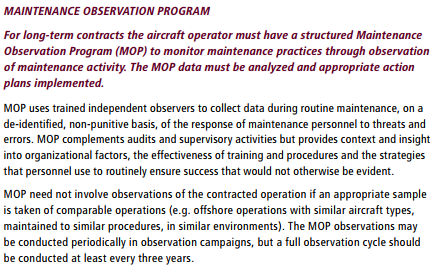 Aerossurance can provide practice guidance and specialist support to successfully implement a MOP.
Aerossurance can provide practice guidance and specialist support to successfully implement a MOP.

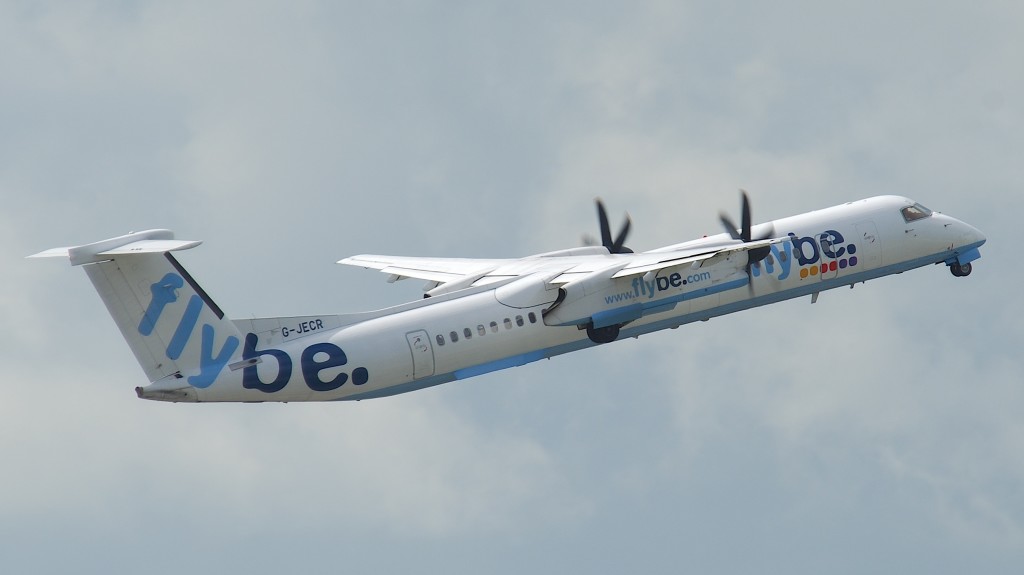

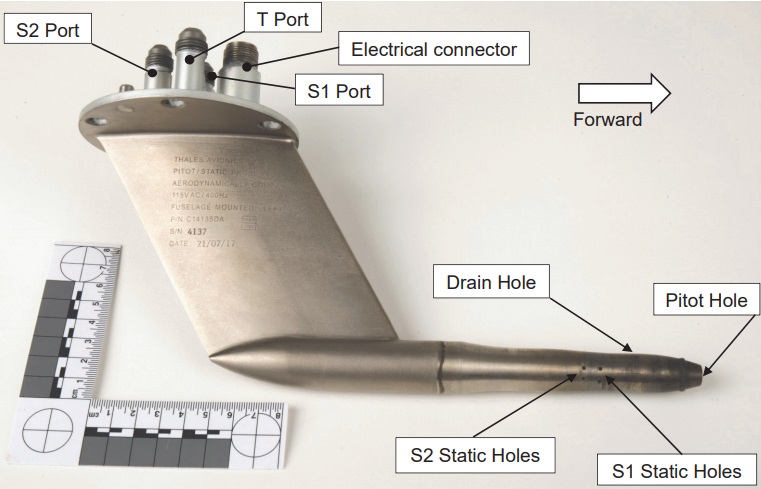


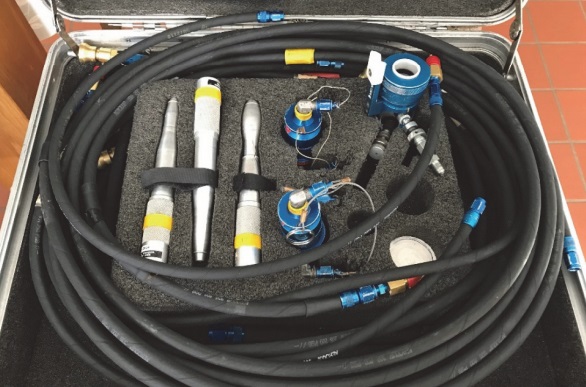
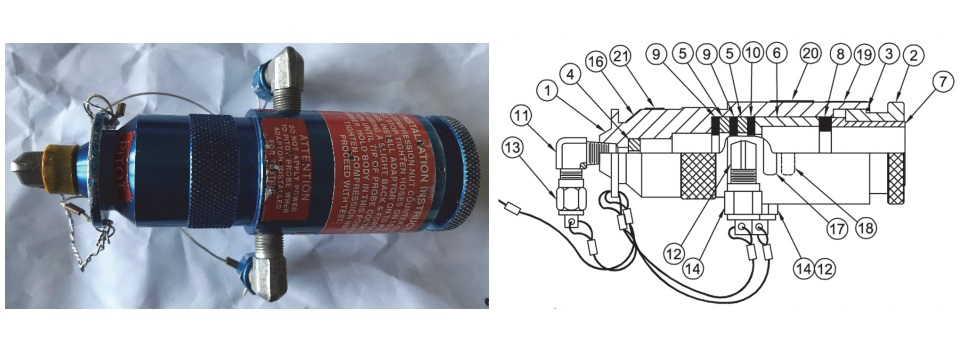

Recent Comments